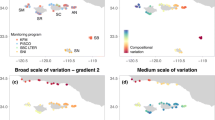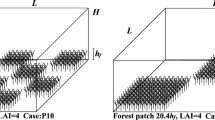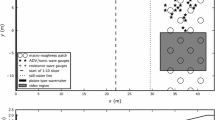Abstract
We present an approach for estimating drag coefficients for depth-averaged tidal flows that uses the ratio of observed RMS velocities to the RMS velocities that would be observed without bottom friction. We find that this ratio, R, depends on a single non-dimensional number, \(P={C}_{D}C{\eta }_{0}/\omega {H}^{2}\), where CD is the drag coefficient, and C is the phase speed of a tidal wave with amplitude \({\eta }_{0}\) and frequency \(\omega\), in water of depth h. The function R(P) can be inverted to solve for CD using measured values of R. Taking advantage of a unique multi-year record of tidal flows on Isla Nativdad, Baja California, Mexico, during which time the kelp forest there varied between non-existent and dense, we use this method to quantify the effect of kelp biomass on drag. This analysis shows that a maximum value of CD ≈ 0.04 is reached for relatively low values of kelp biomass, which may be an effect of sheltering (reductions in the velocity creating drag due to the close proximity of bundles of kelp stipes). However, values as large as 0.015 were observed when the water column experienced strong secondary flows in the presence of strong density stratification. Given that the long-term measurements were made near a coastal headland, we argue that this may reflect variations in secondary flow strength due to stratification. Lastly, our measurements show little evidence of enhancement of drag by surface waves.









Similar content being viewed by others
References
Alnajjar, M.W. 2019. Nearshore processes of a coastal island: physical dynamics and ecological implications. PhD thesis, Stanford University.
Arzeno, I.B., A. Collignon, M. Merrifield, S.N. Giddings, and G. Pawlak. 2018. An alongshore momentum budget over a fringing tropical fore-reef. Journal of Geophysical Research (oceans) 123: 7839–7855.
Bell, T.W., J.G. Allen, K.C. Cavanaugh and D.A. Siegel. 2020. Three decades of variability in California’s giant kelp forests from the Landsat satellites. Remote Sensing of Environment 238 (1). https://doi.org/10.1016/j.rse.2018.06.039.
Boch, C.A., S. Litvin, F. Micheli, G. De Leo, E. Aalto, C. Lovera, B.C. Woodson, S. Monismith, and J.P. Barry. 2017. Effects of current and future coastal upwelling conditions on the fertilization success of the red abalone (Haliotis rufescens). ICES Journal of Marine Science 74 (4): 1125–1134.
Boch, C.A., F. Micheli, M. Alnajjar, S.G. Monismith, J.M. Beers, J.C. Bonilla, A.M. Espinoza, L. Vazquez, and C.B. Woodson. 2018. Local oceanographic variability influences the performance of juvenile abalone under climate change. Scientific Reports 8:5501. https://doi.org/10.1038/s41598-018-23746-z.
Cavole, L.M., A.M. Demko, R.E. Diner, A. Giddings, I. Koester, C.M.L.S. Pagniello, M.-L. Paulsen, A. Ramirez-Valdez, S.M. Schwenck, N.K. Yen, M.E. Zill, and P.J.S. Franks. 2016. Biological impacts of the 2013–2015 warm-water anomaly in the Northeast Pacific: Winners, losers, and the future. Oceanography 29: 273–285.
Di Lorenzo, E., and N. Mantua. 2016. Multi-year persistence of the 2014/15 North Pacific marine heat wave. Nature Climate Change. https://doi.org/10.1038/nclimate3082.
Fischer, H.B., E.J. List, R.C.Y. Koh, J. Imberger, and N.H. Brooks. 1979. Mixing in inland and coastal waters. Academic Press.
Gaylord, B., M.W. Denny, and M.A.R. Koehl. 2003. Modulation of wave forces on kelp canopies by alongshore currents. Limnology and Oceanography 48: 860–871.
Gaylord, B., J.H. Rosman, D.C. Reed, J.R. Koseff, J. Fram, and J., S. MacIntyre, S. K. Arkema, C. McDonald, M.A. Brzezinski, J.L. Largier, S.G. Monismith, P.T. Raimondi, and B. Mardian,. 2007. Spatial patterns of flow and their modification within and around a giant kelp forest. Limnology and Oceanography 52: 1838–1852.
Gaylord, B., M.W. Denny, and M.A.R. Koehl. 2008. Flow forces on seaweeds: Field evidence for roles of wave impingement and organism inertia. Biological Bulletin 215: 295–308.
Gaylord, B., K.J. Nickols, and L. Jurgens. 2012. Roles of transport and mixing processes in kelp forest ecology. Journal of Experimental Biology 215: 997–1007.
Godin, G. 1972. The analysis of tides. University of Toronto Press.
Grant, W.D., and O.S. Madsen. 1979. Combined wave and current interaction with a rough bottom. Journal of Geophysical Research (oceans) 84: 1797–1808.
Jackson, G.A., and C.D. Winant. 1983. Effect of a kelp forest on coastal currents. Continental Shelf Research 2: 75–80.
Kalkwijk, J.P.T., and R. Booij. 1986. Adaptation of secondary flow in nearly horizontal flow. Journal of Hydraulic Research 24: 19–37.
Lentz, S.J., K.A. Davis, J.H. Churchill, and T.M. DeCarlo. 2017. Coral reef drag coefficients–water depth dependence. Journal of Physical Oceanography 47 (5): 1061–1075.
Lentz, S.J., J.H. Churchill, and K.A. Davis. 2018. Coral reef drag coefficients-surface gravity wave enhancement. Journal of Physical Oceanography 48 (7): 1555–1566. https://doi.org/10.1175/JPO-D-17-0231.1.
Monismith, S.G., H. Hirsh, N. Batista, H. Francis, G. Egan, and R.B. Dunbar. 2019. Flow and drag in a seagrass bed. Journal of Geophysical Research (oceans). https://doi.org/10.1029/2018JC0148622019.
Monismith, S.G., M.W. Alnajjar, C.B. Woodson, C.A. Boch, A. Hernandez, L. Vazquez-Vera, T.W. Bell, and F. Micheli. (unpublished). Influence of kelp forest state on the nearshore currents around an island. https://doi.org/10.25740/ng474qg6723.
Mullarney, J.C., and C.A. Pilditch. 2017. The differential response of kelp to swell and infragravity wave motion. Limnology and Oceanography 62: 2524–2537.
Nepf, H.M. 2012. Flow and transport in regions with aquatic vegetation. Annual Reviews of Fluid Mechanics 44: 123–142.
Nidzieko, N.J., S.G. Monismith, and J.L. Hench. 2009. Lateral circulation in well-mixed and stratified estuarine flows with curvature. Journal of Physical Oceanography 39 (4): 834–851.
Prandle, D., and M. RahmanM. 1980. Tidal response in estuaries. Journal of Physical Oceanography 10 (10): 1552–1573.
Reidenbach, M.A., S.G. Monismith, J.R. Koseff, G. Yahel, and A. Genin. 2006. Boundary layer turbulence and flow structure over a fringing coral reef. Limnology and Oceanography 51 (5): 1956–1968.
Rogers, J.S., S.A. Maticka, V. Chirayath, C.B. Woodson, J.J. Alonso, and S.G. Monismith. 2018. Connecting flow over complex terrain to hydrodynamic roughness on a coral reef. Journal of Physical Oceanography 48 (7): 1567–1587.
Rosman, J.H., J.R. Koseff, S.G. Monismith, and J. Grover. 2007. A field investigation into the effects of a kelp forest (Macrocystis pyrifera) on coastal hydrodynamics and transport. Journal of Geophysical Research (Oceans), 112. https://doi.org/10.1029/2005JC003430.
Rosman, J.H., S.G. Monismith, M.A. Denny, and J.R. Koseff. 2010. Currents and turbulence within a kelp forest (Macrocystis pyrifera): Insights from a dynamically scaled laboratory model. Limnology and Oceanography 55: 1145–1158.
Rosman, J.H., M.W. Denny, R.B. Zeller, S.G. Monismith, and J.R. Koseff. 2013. Interaction of waves and currents with kelp forests (Macrocystis pyrifera): Insights from a dynamically scaled laboratory model. Limnology and Oceanography. https://doi.org/10.4319/lo.2013.58.3.0790.
Rosman, J.H., and J.L. Hench. 2011. A framework for understanding drag parameterizations for coral reefs. Journal of Geophysical Research (oceans) 116: C08025. https://doi.org/10.1029/2010JC006892.
Stacey, M.T., S.G. Monismith, and J.R. Burau. 1999. Observations of turbulence in a partially stratified estuary. Journal of Physical Oceanography 29: 1950–1970.
Street, R.L, G.Z. Watters, and J.K. Vennard. 1996. Elementary fluid mechanics 7ed. J. Wiley.
Svendsen, I.A., and U. Putrevu. 1994. Nearshore mixing and dispersion. Proceedings of the Royal Society of London Series A A445: 561–576.
Utter, B.D., and M.W. Denny. 1996. Wave-induced forces on the giant kelp Macrocystis pyrifera (AGARDH): Field test of a computational model. Journal of Experimental Biology 199: 2645–2654.
Valle-Levinson, A., M.A. Daly, B. Juarez, M. Fagundes, C.B. Woodson, and S.G. Monismith. 2022. Influence of kelp forests on flow around headlands. Science of the Total Environment 825: 153952. https://doi.org/10.1016/j.scitotenv.2022.153952.
Woodson, C.B., F. Micheli, C. Boch, M. Al-Najjar, A. Espinoza, A. Hernandez, L. Vázquez-Vera, A. Saenz-Arroyo, S.G. Monismith, and J. Torre. 2018. Harnessing marine microclimates for climate change adaptation and marine conservation. Conservation Letters. https://doi.org/10.1111/conl.12609.
Acknowledgements
We are grateful to the fishers and staff of the cooperative Buzos y Pescadores without whom the data upon which this paper is based would never have been acquired, as well as our colleagues, Fio Micheli, Charlie Boch, Arturo Hernandez, Leonardo Vazquez-Vera, Geno Pawlak, and Jim Leichter.
Funding
The work we describe here was supported by NSF grants OCE 1736830, OCE-1736957, OCE 1737090, and OCE 2022927, and by an equipment grant from the Kuwait Foundation for the Advancement of Sciences.
Author information
Authors and Affiliations
Corresponding author
Additional information
Communicated by David K. Ralston
Rights and permissions
About this article
Cite this article
Monismith, S., Alnajjar, M., Daly, M. et al. Kelp Forest Drag Coefficients Derived from Tidal Flow Data. Estuaries and Coasts 45, 2492–2503 (2022). https://doi.org/10.1007/s12237-022-01098-2
Received:
Revised:
Accepted:
Published:
Issue Date:
DOI: https://doi.org/10.1007/s12237-022-01098-2




